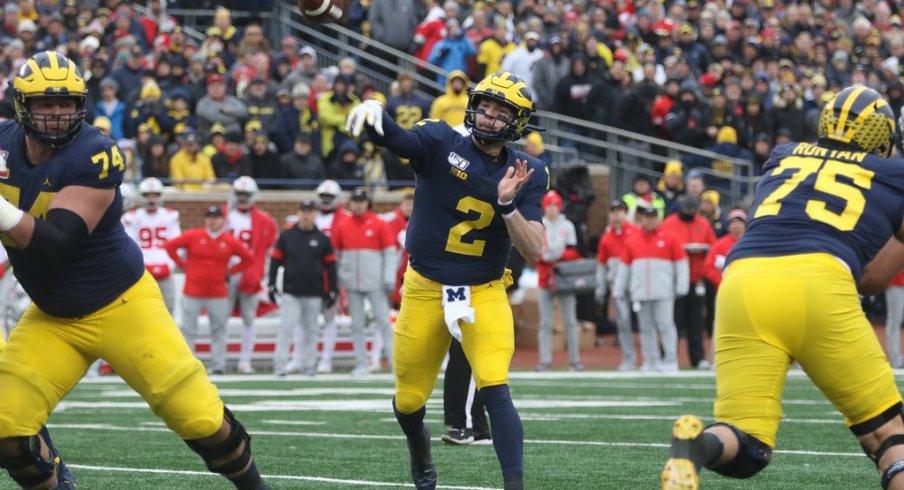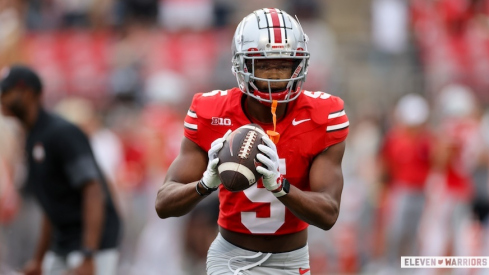“We want to be an attacking offense. We want to be an offense that finds creative ways to put the defense in conflict.” - Josh Gattis
One year ago, the excitement in Ann Arbor was palpable. After years of featuring a top-ranked defense, Jim Harbaugh's program expected to match that output on the offensive side with the hiring of former Alabama coordinator Josh Gattis.
With a former 5-star caliber quarterback and a modern, spread system that had competed at the highest levels of the sport, the Wolverines finally seemed prepared to compete for a Big Ten title. Gattis' system even featured its own branding, labeled 'Speed in Space' and leading many a Michigan Man to believe 2019 was their year.
As we know now, however, Gattis and Harbaugh found mixed success last fall. The Wolverines finished 68th in the nation in total offense, averaging just 401.5 yards-per-game, 18 yards fewer than their average a year before.
Though Harbaugh has historically deemed offensive coordinators largely disposable, Gattis returns for a second season with the full support of the head coach, as do the rest of the offensive assistants. Knowing that 'Speed in Space' isn't going away, then, it's worth exploring what Gattis is trying to accomplish when his team hits the field.
While Gattis came from Alabama, he spent much of his career working for James Franklin at Vanderbilt and Penn State, where he had the chance to learn directly from the man who largely reinvented the Nittany Lion offense in 2016, Joe Moorhead.
"A tremendous offensive mind, who really helped shape who our offense is today and a lot of the core values and plays that we run today," Gattis said of Moorhead in a recent interview with All-22 Breakdown. "I was able to learn a lot from him.”
In the same interview, Gattis laid out his philosophy as a play-caller, which has three focus areas:
- Protect the football
- Create explosive plays
- Eliminate negative plays
With those in mind, it's worth evaluating what went well for Gattis' offense last fall and where it fell short.
1. Protect The Football
As anyone who followed the 2019 Wolverine season will recall, this was not exactly a strong suit for Gattis' troops. The unit finished 102nd in the nation with 11 lost fumbles, seven of which came in the first three weeks.
In total, the Wolverines turned it over 14 times in the first seven games, which included two crucial road losses at Wisconsin and Penn State which largely ended any championship hopes for the faithful up north. The problem appeared to lie primarily with traditional ballhandling, as Patterson threw just eight interceptions all year, placing him in the middle of the pack among Big Ten starters (in-state rival Brian Lewerke led the league with 13).
The timing of many fumbles couldn't have been worse, either. Against Ohio State, the Wolverines traded punches throughout the first half and trailed 21-13 midway through the second quarter and seemed poised to finish a second-straight drive in the end zone until...
The Buckeyes would immediately reel off a nine-play, 84-yard touchdown drive and The Game would never again be in doubt.
Patterson, himself, was largely the culprit for such turnovers throughout the season, fumbling nine times, the fourth-highest total for any FBS player last season. Overall, the Wolverines took a major step back in this area, turning it over 20 times compared to a B1G-leading 12 instances in 2018.
2. Create Explosive Plays
When the Wolverines were able to hang onto the ball, they did create more big plays than Harbaugh's teams had in the past. Compared to the year before, the 2019 Wolverines generated more gains of 10+ yards (188 to 175), and 20+ yards (68 to 61).
With offensive line coach Ed Warinner remaining on staff, the Wolverines maintained a run game playbook resembling most other spread teams.
“We run Outside Zone, we run Inside Zone, we run gap schemes: Counter and Power, Pin & Pull…I believe in being diverse in the run game," Gattis said of his playbook. "I don’t believe in having just one or two concepts and just running them until you get good at them, I think you’ve got to have different ways to attack defenses, whether that’s by front, numbers, or angles, but different things you’ve got to ask your linemen to do, but that’s the pro-style element of the pro-spread."
While the Pin & Pull sweep eventually proved to be the most successful single concept from week to week, the 2019 Wolverines largely struggled to generate much in the way of big plays on the ground. At 3.96 yards-per-carry, the team finished just 89th nationally as lead back Zach Charbonnet broke just three of his 149 carries for 20 yards or more.
But Gattis still found ways to pick up the occasional big gain on the ground. All the window dressing on this end-around sprung wide receiver Giles Jackson for an early touchdown against the Buckeyes, as outside linebacker Pete Werner was sealed inside by the tight end (#84) who came all the way across the formation in what initially appeared to be a Split-Zone inside run.
Such distractions as the fake handoff inside are a trademark of Gattis' offense. According to him, there are four ways to put a defense in conflict by making the defender sit on his heels and think, even if just for an instant:
- Tempo
- Formations
- Motions
- RPOs
“You take a 10th of a second off a defender’s 40 time by making him have to think,” Gattis said of these added distractions.
The Wolverines didn't go with a quick tempo all that often, but they did incorporate a wide variety of formations. According to Gattis, this is the first element he designs in his weekly game plans, as he wants to make defenses line up in uncomfortable positions and have to adjust on the fly before the ball is even snapped.
Similarly, he calls for motion frequently and from virtually every skill player on the field. This constant barrage of seemingly simple pre-snap alignments can be deadly if not accounted for properly, as the usually disciplined OSU defense showed.
The most consistently successful piece of Gattis offense was the use of RPOs. Patterson had shown a knack for making such quick reads earlier in his career while at Ole Miss, and Gattis wasn't afraid to call them despite the lack of an explosive running game.
These were not simple 'reliefs' as often seen in Columbus, which simply add a quick screen or slant to a run play in place of a traditional zone-read. Rather, Gattis would attach full route concepts with multiple receivers to a designed run, giving Patterson multiple reads on the same play.
In this sense, the Wolverine largely resembles the Penn State offense under Moorhead, which regularly implemented such RPOs to keep defenses on their heels. However, Gattis took it a step further by sometimes splitting the field in half and running two unique plays at once.
Above, the center, right guard, right tackle, and tight end all block an Outside Zone run while the left guard and tackle are in a pass-blocking set as the three receivers to that side run the old Air Raid Stick concept, asking Patterson to read the alley defender for a quick pass.
In another instance, Patterson actually is asked to make an "advancement" read, working from one side of the field to the other with receivers on either side, should the defense play the handoff.
Packaging such concepts are a big reason why the Wolverines improved from 64 completions of 15+ yards in 2018 to 85 in 2019.
3. Eliminate Negative Plays
While Patterson proved adept at creating big plays, he also accounted for a number of negative ones as well. Far too often the quarterback simply missed open reads that would have led to explosive plays and instead took a sack (sometimes leading to the aforementioned fumbles).
Once again, despite the focus on this area, Harbaugh's offense regressed in 2019. After giving up 23 sacks the year before, Wolverine QBs were sacked 25 times last season. Similarly, with an underwhelming run game, they gave up 63 overall tackles-for-loss compared to just 60 in 2018.
But beyond the literal interpretation of a negative play, the Wolverine offense left plenty of opportunities to move the ball on the field, thanks largely to Patterson. Even when he identified an open pattern downfield, his accuracy was spotty at best, sometimes leading the receiver right into a defender instead of toward open grass.
While the senior QB did suffer an oblique injury early in the season which seemed to hamper his play, many of his statistical metrics went in the wrong direction despite a system largely designed to suit his strengths. His completion percentage dropped from 64% to 56% while his QB rating dipped from 149.85 to 139.38, with just a 108.08 rating against ranked opponents.
As Gattis enters year two of implementing his system in Ann Arbor, he may well experience addition-by-subtraction with the loss of Patterson. However, with the loss of four offensive linemen, a starting tight end, and the team's most talented receiver, breaking in a new QB becomes that much harder. Add in the fact that the Wolverines did not hold a single spring practice before the Coronavirus shut things down in March and Gattis has little margin for error.
But if the Wolverines can get anything more out of their run game, the elements of a successful offense are in place, as Gattis proved a capable play-caller in his first season doing so. The Wolverine offense schemed up a number of big plays and largely tempered its turnover problems in the second half of the year.
Gattis earned another year at the helm of the Ann Arbor offense with the growth his unit showed as the season went on. Whether he can eventually make up for the talent gap between his players their rivals in Columbus remains an entirely different conversation, though.



